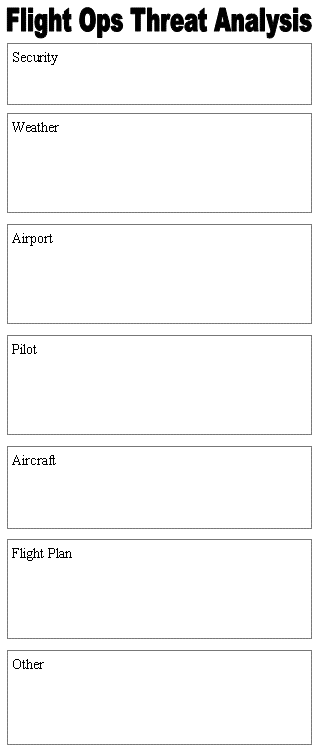
 | ||
| Home | Login | Schedule | Pilot Store | 7-Day IFR | IFR Adventure | Trip Reports | Blog | Fun | Reviews | Weather | Articles | Links | Helicopter | Download | Bio | ||
Site MapSubscribePrivate Pilot Learn to Fly Instrument Pilot 7 day IFR Rating IFR Adventure Commercial Pilot Multi-Engine Pilot Human Factors/CRM Recurrent Training Ground Schools Articles Privacy Policy About Me Keyword:  |
Threat & Error Series:
Threats to Safety | Intro to TEM | Error
Management | Integrating TEM | TEM
Countermeasures
 A great way to avoid threat and resist error is
performing a briefing. Briefings can bring an added element
of safety to your flight by reviewing the threats for your flight, your
takeoff, your approach, etc. Pilots who perform quality
briefings, even single pilot, exhibit active leadership, airmanship,
and professionalism. Much has been written in these pages about
Threat & Error Management. This article introduces a tool you
can use on every flight. The FOTA briefing. A great way to avoid threat and resist error is
performing a briefing. Briefings can bring an added element
of safety to your flight by reviewing the threats for your flight, your
takeoff, your approach, etc. Pilots who perform quality
briefings, even single pilot, exhibit active leadership, airmanship,
and professionalism. Much has been written in these pages about
Threat & Error Management. This article introduces a tool you
can use on every flight. The FOTA briefing.The Flight Operations Threat Analysis (FOTA) briefing analyzes the threats facing the flight so that pilots can perform active avoidance of potential problems that can occur during a flight. You learned from the Threat & Error Management model that if you avoid the threat, it usually doesn't occur. Your avoidance activities will go a long way to minimizing a threat even if it does occur and results in easier threat management. If your threat management is successful, then the error is resisted and prevented. An active Threat & Error Management mindset is required for today's complex operating environment. The FOTA briefing model used for every flight will go a long way to bringing an "airline level of safety" to your flying. The briefing items include: Security: any security related concerns, TFRs, etc. Weather: departure, enroute, and arrival weather conditions were reviewed during your flight planning. The high points are covered here. Any items from your Personal Minimums Checklist which are at your limits should be included also. Airport: conditions such as runway/LZ slope, size, type, and condition were reviewed during your preflight planning. Concerns should be listed here along with any parameter near its limits. For example wind conditions may be at or near your maximum demonstrated crosswind limitations for your aircraft. Pilot: your experience considering the parameters of your flight, including recency, and any items from your Personal Minimums Checklist which are at your limits should be included also. Aircraft: any airworthiness issues, inoperative equipment should be listed. Any performance considerations from your preflight planning should also be listed (i.e. takeoff and landing charts, etc). Flight Plan: any concerns in your fuel plan, altitudes in use, enroute emergency plans, and time available for the flight should be considered and listed. Other: any other considerations that affect the safety of your flight should be listed. Your Thoughts... |
`
|
| Home | Login | Schedule | Pilot Store | 7-Day IFR | IFR Adventure | Trip Reports | Blog | Fun | Reviews | Weather | Articles | Links | Helicopter | Download | Bio |
| All content is Copyright 2002-2010 by Darren Smith. All rights reserved. Subject to change without notice. This website is not a substitute for competent flight instruction. There are no representations or warranties of any kind made pertaining to this service/information and any warranty, express or implied, is excluded and disclaimed including but not limited to the implied warranties of merchantability and/or fitness for a particular purpose. Under no circumstances or theories of liability, including without limitation the negligence of any party, contract, warranty or strict liability in tort, shall the website creator/author or any of its affiliated or related organizations be liable for any direct, indirect, incidental, special, consequential or punitive damages as a result of the use of, or the inability to use, any information provided through this service even if advised of the possibility of such damages. For more information about this website, including the privacy policy, see about this website. |